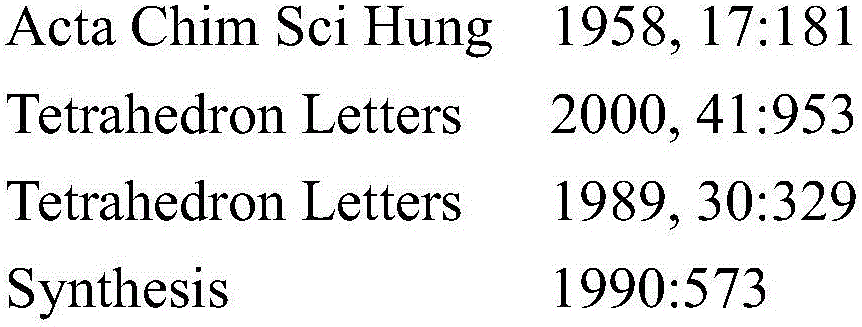Preparation methods for ephedrine or pseudoephedrine and for ephedrine or pseudoephedrine intermediate
A technique for pseudoephedrine and ephedrine is applied in the field of preparation of ephedrine or pseudoephedrine and intermediates of ephedrine or pseudoephedrine, and can solve the problems of large environmental pollution, difficulty in industrialization implementation and high cost
- Summary
- Abstract
- Description
- Claims
- Application Information
AI Technical Summary
Problems solved by technology
Method used
Image
Examples
Embodiment 1
[0091] Embodiment 1 (excessive benzene is used for Friedel-Crafts reaction and is directly used as the solvent of methylation reaction)
[0092] Add benzene (500 milliliters, 5.6 moles) and anhydrous aluminum chloride (300 grams, 2.25 moles) in a 2-liter reaction flask under nitrogen protection, stir and cool down to 0-5 ° C, and slowly dissolve the 2 - Chloropropionyl chloride (254 g, 2.0 moles) was added to the reaction flask. Keep the reaction temperature below 10°C and continue the reaction for one hour. Then the temperature was raised to 20-30° C. to react for two hours. Gas phase analysis no longer showed the presence of 2-chloropropionyl chloride.
[0093] Add 600 ml of ice water and 150 ml of 35% hydrochloric acid successively to decompose excess aluminum chloride. The reaction solution was left to stand for stratification, and the upper benzene layer was taken, washed with water once, and then left to stand for thorough separation. The benzene liquid shows that th...
Embodiment 2
[0094] Embodiment 2 (Toluene replaces benzene as the solvent of methylation reaction)
[0095] Benzene (350 ml, 3.94 mol) and anhydrous aluminum trichloride (300 g, 2.25 mol) were added to a 2 liter reaction flask under nitrogen protection. 2-Chloropropionyl chloride (254 g, 2.0 mol) was added dropwise when the temperature was cooled to 0-5°C with stirring. After 30 minutes of dropwise addition, the temperature was raised to 20-30°C, and the reaction was continued for three hours. The gas phase showed no more 2-chloropropionyl chloride remained.
[0096] 600 ml of ice water and 150 ml of 35% concentrated hydrochloric acid were added to the reaction solution successively. Continue to stir for 15 minutes after the dripping, and then let stand to separate layers. The upper benzene layer was washed once with water and allowed to stand for separation. The separated benzene layer solution was evaporated to remove benzene. Add 800 milliliters of toluene until about 1 / 3 volume an...
Embodiment 3
[0097] Embodiment 3 (acetonitrile replaces benzene as the solvent of methylamination reaction)
[0098] Add benzene (600 ml, 6.73 moles) and anhydrous aluminum trichloride (300 grams, 2.25 moles) to a 2-liter reaction flask under nitrogen protection, stir and cool down to 0-5°C, and start to add 2-chloro Propionyl chloride (254 g, 2.0 mol). After 30 minutes of addition, the temperature was raised to 20-30°C for three hours. The gas phase showed that 2-chloropropionyl chloride was completely consumed.
[0099] 400 ml of ice water was slowly added dropwise to the reaction solution, and after stirring for ten minutes, 150 ml of 35% concentrated hydrochloric acid was added. Layering was carried out after stirring for another ten minutes after dropping. The upper benzene layer was washed once with water, and the layers were separated again. The separated benzene layer was concentrated under normal pressure, and when the solution was nearly dry, 500 ml of anhydrous acetonitrile ...
PUM
 Login to View More
Login to View More Abstract
Description
Claims
Application Information
 Login to View More
Login to View More - R&D
- Intellectual Property
- Life Sciences
- Materials
- Tech Scout
- Unparalleled Data Quality
- Higher Quality Content
- 60% Fewer Hallucinations
Browse by: Latest US Patents, China's latest patents, Technical Efficacy Thesaurus, Application Domain, Technology Topic, Popular Technical Reports.
© 2025 PatSnap. All rights reserved.Legal|Privacy policy|Modern Slavery Act Transparency Statement|Sitemap|About US| Contact US: help@patsnap.com



